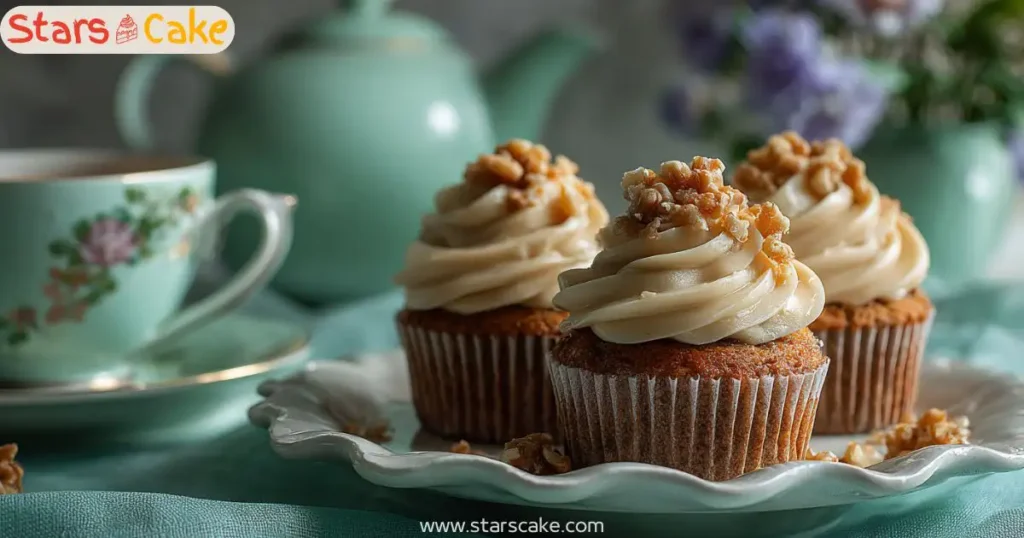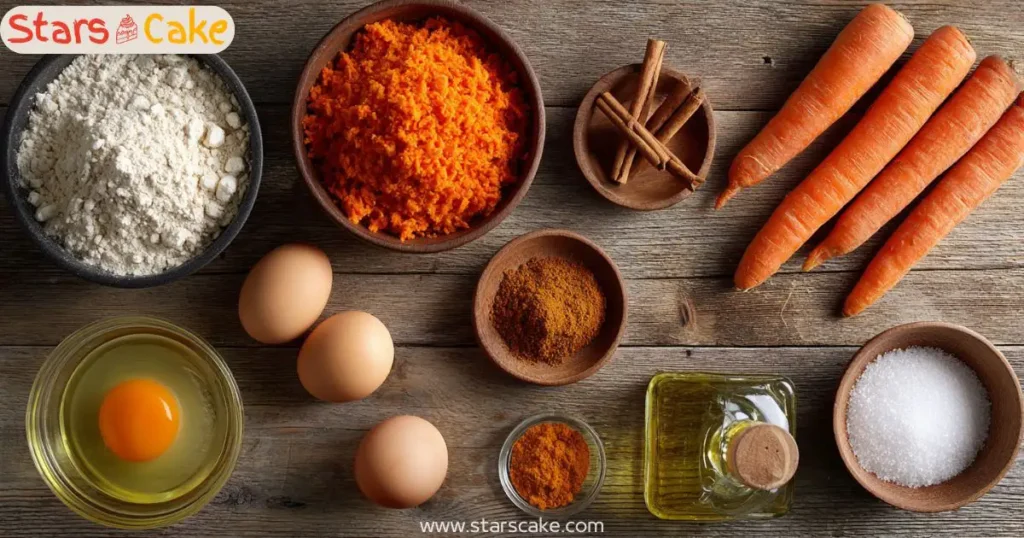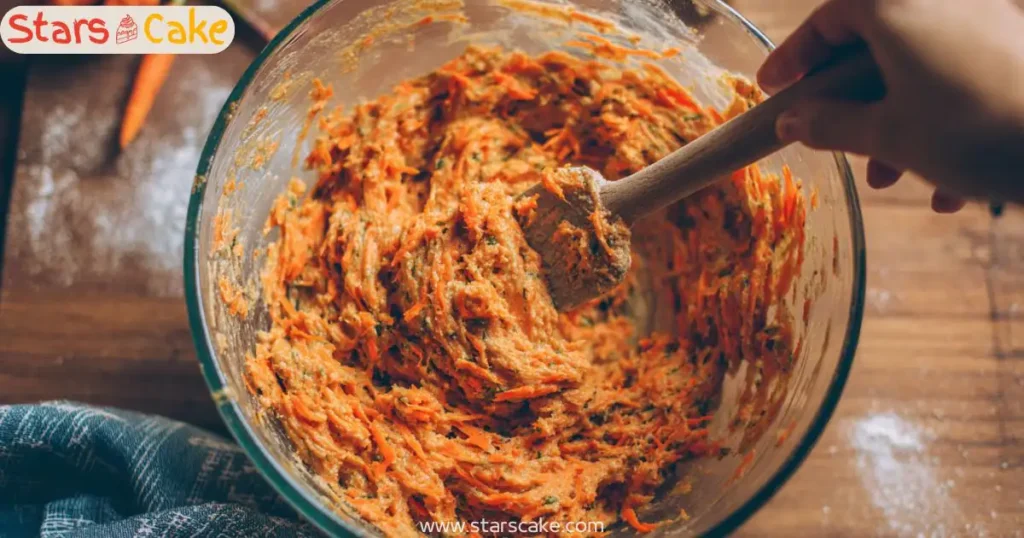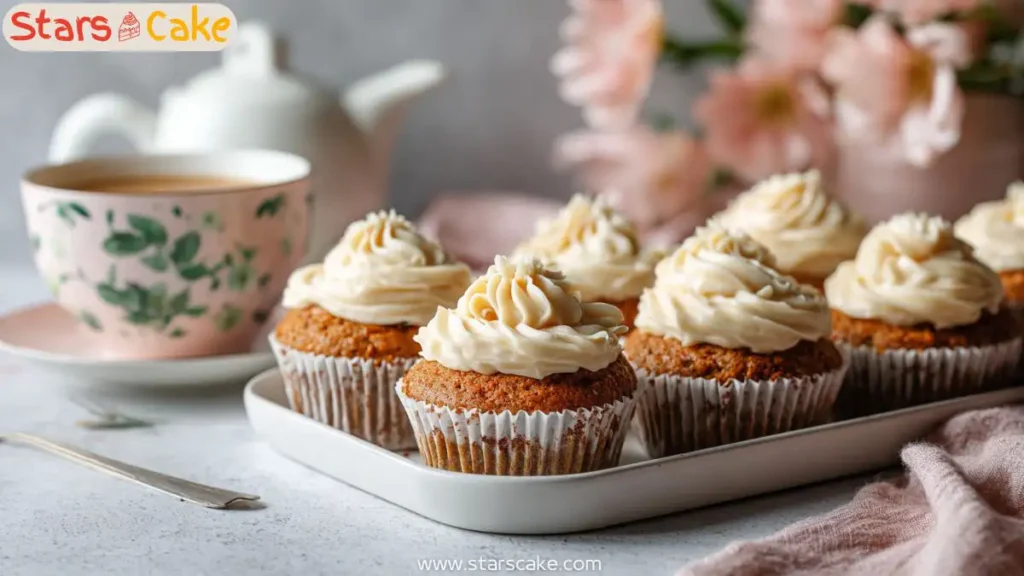Last updated on July 25th, 2025 at 11:13 am
Table of Contents
The Recipe
Gluten Free Carrot Cake Cupcakes

Bake moist and fluffy gluten-free carrot cake cupcakes with rich caramel cream cheese frosting. Perfect for birthdays, brunches, or allergy-friendly treats.
Type: Dessert
Cuisine: American
Keywords: gluten free cupcakes, gluten free carrot cake, carrot cupcakes, gluten free dessert, caramel frosting cupcakes
Recipe Yield: 12 cupcakes
Calories: 420
Preparation Time: PT25M
Cooking Time: PT22M
Total Time: PT47M
Recipe Ingredients:
- 4 large eggs
- 2 cups (380g) granulated sugar
- 1 cup (236ml) vegetable oil
- 2 cups (280g) 1:1 gluten-free all-purpose flour with xanthan gum
- 2 teaspoons (8.5g) baking soda
- 1 teaspoon (5g) salt
- 2 teaspoons (8.5g) ground cinnamon
- 3 cups grated raw carrots
- 1 cup chopped walnuts (optional)
- 1 cup raisins (optional)
- 1 cup (226g) unsalted butter, cold
- 16 oz cold cream cheese
- 6–7 cups (780g) powdered sugar
- 2 tsp vanilla extract
- 2 tbsp salted caramel sauce
- 1–2 tsp heavy cream or milk (optional)
- Pinch of salt
Step By Step
- Preheat oven to 350°F (175°C) and line a 12-cup muffin pan with paper liners for easy release and even baking.
- Lightly beat the eggs in a large bowl. Add sugar and mix until slightly frothy, then stir in vegetable oil until fully combined.
- In a separate bowl, whisk together gluten-free flour, baking soda, salt, and cinnamon. Gradually mix into the wet mixture until combined.
- Fold in freshly grated carrots. Add raisins and walnuts if using.
- Scoop batter into liners, filling ⅔ full. Bake for 18–22 minutes or until a toothpick inserted comes out clean. Cool completely.
- Cut cold butter into chunks and beat until slightly softened.
- Beat in cold cream cheese until smooth and fluffy.
- Gradually add powdered sugar, vanilla, salted caramel, and a pinch of salt. Add milk if needed for texture. Beat until smooth.
- Once cupcakes are fully cooled, frost with a piping bag or spoon. Store in fridge up to 5 days; bring to room temp before serving.
Summary
Bake moist and fluffy gluten-free carrot cake cupcakes with rich caramel cream cheese frosting. Perfect for birthdays, brunches, or allergy-friendly treats.
Tips
- Use a 1:1 gluten-free flour with xanthan gum for best texture.
- Let batter rest 10–15 mins before baking to hydrate starches.
- Freshly grated carrots provide superior moisture and sweetness.
- Don't overmix the batter—mix just until dry ingredients disappear.
- Cold cream cheese and butter help the frosting stay thick and swirled.
For The Reading Lovers
Gluten-free baking can feel a little intimidating, especially when you’re aiming for cupcakes that are light, moist, and full of flavor. But don’t worry—this guide breaks it all down for you. Today we’re diving into how to make the best gluten free carrot cake cupcakes from scratch. From essential ingredients to fluffy frosting tricks, you’ll discover everything you need to confidently bake cupcakes that’ll wow your family and friends—gluten-free or not. These gluten free carrot cake cupcakes are the perfect treat for birthdays, holidays, or casual weekend baking.

The Story & Why These Gluten Free Carrot Cake Cupcakes Work
A Cupcake Memory That Sparked Something Special
I remember the first time I baked carrot cupcakes for my daughter’s spring birthday party. Back then, I wasn’t thinking gluten-free. I just wanted something cheerful, moist, and packed with cozy spices. But when one of her little guests had a gluten allergy, I scrambled to adapt. That afternoon, I tested a 1:1 gluten-free flour blend and crossed my fingers. What came out of the oven was pure magic—moist, gently spiced cupcakes with fluffy, dreamy cream cheese frosting. They were gone within minutes. That moment taught me that gluten-free baking doesn’t mean compromise—it means creativity.
The secret to moist, tender gluten free carrot cake cupcakes lies in the balance of fresh carrots, neutral oil, and a dependable gluten-free flour blend.
Since then, I’ve made these gluten free carrot cake cupcakes for Easter brunch, playdates, and even grown-up tea parties. They’re consistently the most requested recipe from my gluten-free section, and there’s a good reason why. They tick every box: simple ingredients, easy method, and results that make you proud. Whether you’re new to gluten-free baking or looking for a cupcake everyone will love, this is the one. It’s a go-to recipe in my kitchen—and now it can be in yours, too.
Why Gluten Free Carrot Cake Cupcakes Are Worth Making
The secret to moist and flavorful gluten free carrot cake cupcakes lies in the balance of freshly grated carrots, warm spices, and a dependable gluten-free flour blend. This recipe uses a 1:1 gluten-free all-purpose flour, which means no complicated measurements or added gums—just swap it into your favorite baking recipes and go. If you’re looking for a no-fail recipe for gluten free carrot cake cupcakes, this one is tested, trusted, and family-approved.
What makes these cupcakes so special is their texture: soft, fluffy, and never gritty. And when topped with a swirl of salted caramel cream cheese frosting? It’s next-level indulgence. You can even skip the nuts and raisins if you’re serving picky eaters. Want to try more creative cake ideas that work for all ages? These bluey cake and lunchbox cake options are family favorites, too.
When you’re craving something classic with a twist, these gluten free carrot cake cupcakes will never disappoint. From taste to texture, they prove gluten-free baking doesn’t have to feel like a second-best choice. They’re festive, foolproof, and full of joy.
Always use freshly grated carrots when making gluten free carrot cake cupcakes—it’s the secret to unbeatable texture and natural sweetness.
Ingredients & Step-by-Step Instructions for Gluten Free Carrot Cake Cupcakes

Essential Ingredients and Why Each One Matters
When baking gluten-free, every ingredient plays a role in achieving the right taste and texture. Here’s what you’ll need:
For the Cupcakes:
- 4 large eggs – help structure and bind the cupcakes.
- 2 cups (380g) granulated sugar – keeps the crumb moist and sweet.
- 1 cup (236ml) vegetable oil – adds richness and tenderness without dairy.
- 2 cups (280g) 1:1 gluten-free all-purpose flour – choose a blend with xanthan gum for structure.
- 2 teaspoons (8.5g) baking soda – provides lift.
- 1 teaspoon (5g) salt – balances the sweetness.
- 2 teaspoons (8.5g) ground cinnamon – adds cozy warmth.
- 3 cups grated raw carrots – moisture and natural sweetness.
- 1 cup chopped walnuts (optional) – for crunch and nutty flavor.
- 1 cup raisins (optional) – subtle chew and added sweetness.
For the Cream Cheese Frosting:
- 1 cup (226g) unsalted butter, cold – helps the frosting hold its shape.
- 16 oz cold cream cheese – adds that classic tangy richness.
- 6–7 cups (780g) powdered sugar – sweetens and thickens.
- 2 tsp vanilla extract – for flavor depth.
- 2 tbsp salted caramel sauce – adds a rich twist.
- 1–2 tsp heavy cream or milk (optional) – adjust frosting texture.
- Pinch of salt – brings it all together.
Make it your own! You can skip the nuts for school-safe lunches or add a dash of nutmeg. Want more baking fun? This protein mug cake or pickle cake offers fun flavor experiments for curious bakers.
Step-by-Step Instructions with Expert Tips
Step 1: Prep your cupcake pan
Preheat the oven to 350°F (175°C). Line a 12-cup cupcake pan with paper liners. This ensures even baking and easy clean-up.
Step 2: Mix the wet ingredients
In a large mixing bowl, lightly beat the eggs. Add sugar and beat until the mixture looks smooth and slightly frothy—this adds air for a softer crumb. Then pour in the oil and mix again until fully combined.
Step 3: Combine dry ingredients
In a separate bowl, whisk together the gluten-free flour, baking soda, salt, and cinnamon. Slowly add the dry mix to your wet mixture. Beat on low speed until no dry streaks remain—this helps avoid overmixing, which can make GF batter gummy.
Step 4: Add grated carrots (and extras!)
Fold in the shredded carrots. They’ll release moisture during baking, keeping your cupcakes tender. Add raisins and walnuts if using. This part is totally customizable depending on your family’s taste.
Step 5: Fill and bake
Use a large cookie scoop to divide the batter evenly among the cupcake liners—fill each one about ⅔ full. Bake for 18–22 minutes, or until a toothpick inserted into the center comes out clean. Let them cool completely on a wire rack before frosting.
Step 6: Make the frosting
Cut the cold butter into chunks and beat for 1–2 minutes until it softens slightly. Add cream cheese and beat together until smooth and fluffy—this step is key for a luscious texture. Add powdered sugar slowly, along with vanilla, caramel sauce, and a pinch of salt. If the frosting feels too thick, add a splash of milk or cream. Beat until creamy and smooth.
Step 7: Frost and serve
Once cupcakes are completely cool, frost using a piping bag or a spoon. Store frosted cupcakes in the fridge for 4–5 days, but let them sit out for 15 minutes before serving so they’re soft and creamy.
For more creamy indulgence, this greek yogurt cake also brings moisture and tang to the table beautifully.

Expert Baking Tips & Allergy-Friendly Swaps for Gluten Free Carrot Cupcakes
Top Tricks for Moist, Fluffy, Gluten-Free Cupcakes Every Time
Getting the perfect gluten-free cupcake isn’t just about swapping flour—it’s about using the right techniques. Here are my tried-and-true secrets for baking gluten free carrot cake cupcakes that turn out moist and fluffy every time.
Many gluten-free cupcake recipes struggle with dryness, but these gluten free carrot cake cupcakes stay soft for days—even when made ahead or frozen.
1. Use a quality 1:1 gluten-free flour blend
The most reliable results come from a “measure-for-measure” flour that includes xanthan gum or guar gum. This gives your gluten free carrot cake cupcakes a tender structure without crumbling. Bob’s Red Mill and King Arthur are both excellent choices.
2. Don’t overmix the batter
Mix just until the flour disappears. Overmixing can make gluten-free batters gummy or dense, especially in carrot cupcake recipes.
3. Let your batter rest (optional but powerful)
If you have a few minutes to spare, let the batter sit for 10–15 minutes before scooping. This gives the gluten-free starches time to absorb moisture, improving your cupcakes’ final texture.
4. Grate fresh carrots—not pre-shredded
Freshly grated carrots release moisture and sweetness naturally. Store-bought shredded carrots are often too dry and thick, which affects your cupcake’s texture.
5. Use cold cream cheese and butter for frosting
This technique helps your caramel cream cheese frosting stay thick and pipeable. It’s perfect for decorating your gluten free carrot cake cupcakes with beautiful swirls.
6. Don’t skip the salt in frosting
Even a small pinch enhances the overall flavor and balances out the sweetness. It’s one of those “invisible” tricks that makes a big impact.
Want even more creative baking inspiration? The kunafa cake adds Middle Eastern flair, while this boba cake is always a hit with kids. And yes—gluten free carrot cake cupcakes also freeze beautifully, making them ideal for busy weeks or advance prep.

Allergy-Friendly Substitutions That Actually Work
Whether you’re baking for a crowd or managing food sensitivities, these easy swaps help you bake inclusive cupcakes that still taste amazing.
- Dairy-Free: Replace cream cheese with dairy-free cream cheese (like Kite Hill or Miyoko’s) and use vegan butter for the frosting. The cupcake batter itself is already dairy-free!
- Nut-Free: Skip the walnuts and double-check that your gluten-free flour blend is processed in a nut-free facility.
- Egg-Free: While this recipe relies on eggs for structure, you can experiment using flax eggs or an egg replacer like Bob’s Red Mill Egg Replacer. Use 1 tablespoon flaxseed meal + 3 tablespoons water per egg, mixed and rested for 5 minutes.
- Lower Sugar Option: Reduce the granulated sugar in the cupcakes to 1½ cups and use less powdered sugar in the frosting to taste. The carrots naturally sweeten things up!
- Raisin-Free or Swap: Not a fan of raisins? Try chopped dates, golden raisins, or even finely diced dried pineapple for a little tropical flair.
By understanding how ingredients interact in gluten-free baking, you can swap with confidence and still get that crave-worthy texture and flavor. Just like with our baklava cake, a few thoughtful swaps can turn a classic into something uniquely yours.
Bake Joyfully, Gluten-Free and Family-Approved
Baking gluten free carrot cake cupcakes doesn’t have to feel overwhelming. With the right ingredients, a few smart tricks, and a recipe that’s been lovingly tested in a real family kitchen, you’ll have cupcakes that wow every time. Whether you’re baking for a birthday, brunch, or just because—it’s comforting to know you can whip up something sweet, safe, and sincerely delicious. Emma’s mission is to make joyful baking approachable for busy parents, and this recipe fits that perfectly. Happy baking—and don’t forget to share your cupcakes (or sneak one for yourself!).
Once you try these gluten free carrot cake cupcakes, you’ll want to make them a staple in your baking rotation.
Troubleshooting, FAQs & Why This Recipe Works Every Time
What is the best gluten-free flour to use for cupcakes?
The best gluten-free flour for cupcakes is a 1:1 or “measure for measure” blend that includes xanthan gum. This gum mimics the elasticity of gluten and holds everything together while keeping the crumb soft. Brands like King Arthur Measure for Measure and Bob’s Red Mill 1-to-1 are top choices because they deliver consistent texture without grittiness. Avoid single-flour bases (like only rice or almond flour) unless you’re an advanced baker—they usually need binders or starches to work.
How to make gluten free carrot cupcakes that taste like the original?
To make gluten free carrot cupcakes that rival the classic, start with high-moisture ingredients like fresh carrots and oil. Use a gluten-free flour blend with stabilizers like xanthan gum, and always incorporate eggs to provide lift and structure. Resting the batter for a few minutes also helps reduce graininess. The spiced sweetness and the rich frosting in this recipe perfectly mask any subtle flour differences—most tasters won’t even realize they’re gluten-free!
If you love experimenting, you might also enjoy the twist in this lemon mascarpone cake—it shows how different ingredients still yield rich, flavorful cakes.
How does gluten-free flour affect cupcakes?
Gluten-free flour can change both the texture and structure of cupcakes. Without gluten to trap air, cupcakes may be denser or drier if not balanced with moisture-rich ingredients (like eggs, oil, or carrots). The key is finding the right blend—those with rice flour, starches, and xanthan gum give a springy texture. That’s why this recipe works so well: the carrots provide hydration, and the blend keeps the crumb tender, even after a day in the fridge.
What is the trick to baking with gluten-free flour?
The biggest trick is managing moisture and structure. Use ingredients that naturally hydrate (like shredded vegetables, fruit purees, or yogurt) and don’t overmix the batter. Gluten-free batters benefit from a short rest before baking to hydrate the starches fully. Measuring flour correctly—by weight or spoon-and-level—is also critical, as too much can dry out your cupcakes.
If you’re looking for new ways to add moisture and balance, try the strawberry banana pudding as a cupcake filler—it brings unexpected softness to your bake.
What is the secret ingredient in carrot cake?
Most bakers will say it’s the carrots, but we’ll let you in on Emma’s twist: it’s salted caramel in the frosting. Just a couple of tablespoons elevate the frosting’s flavor without overpowering it. It rounds out the sweet and spicy notes of the cupcake, creating a bite that’s layered, rich, and unforgettable. It’s the kind of flavor that leaves people saying, “what is that?” in the best way possible.
Why This Recipe Works: Trust Emma’s Method
As a professional cake artist and mom, Emma’s tested this gluten free carrot cake cupcake recipe in real kitchens for real families. From spring parties to classroom birthdays, she’s fine-tuned it to be as forgiving and flexible as it is delicious. Each ingredient is there for a reason—moisture, flavor, structure—and the steps are clear enough for first-time bakers. Whether you’re baking for allergies or just looking for something everyone will love, this is your new go-to.


